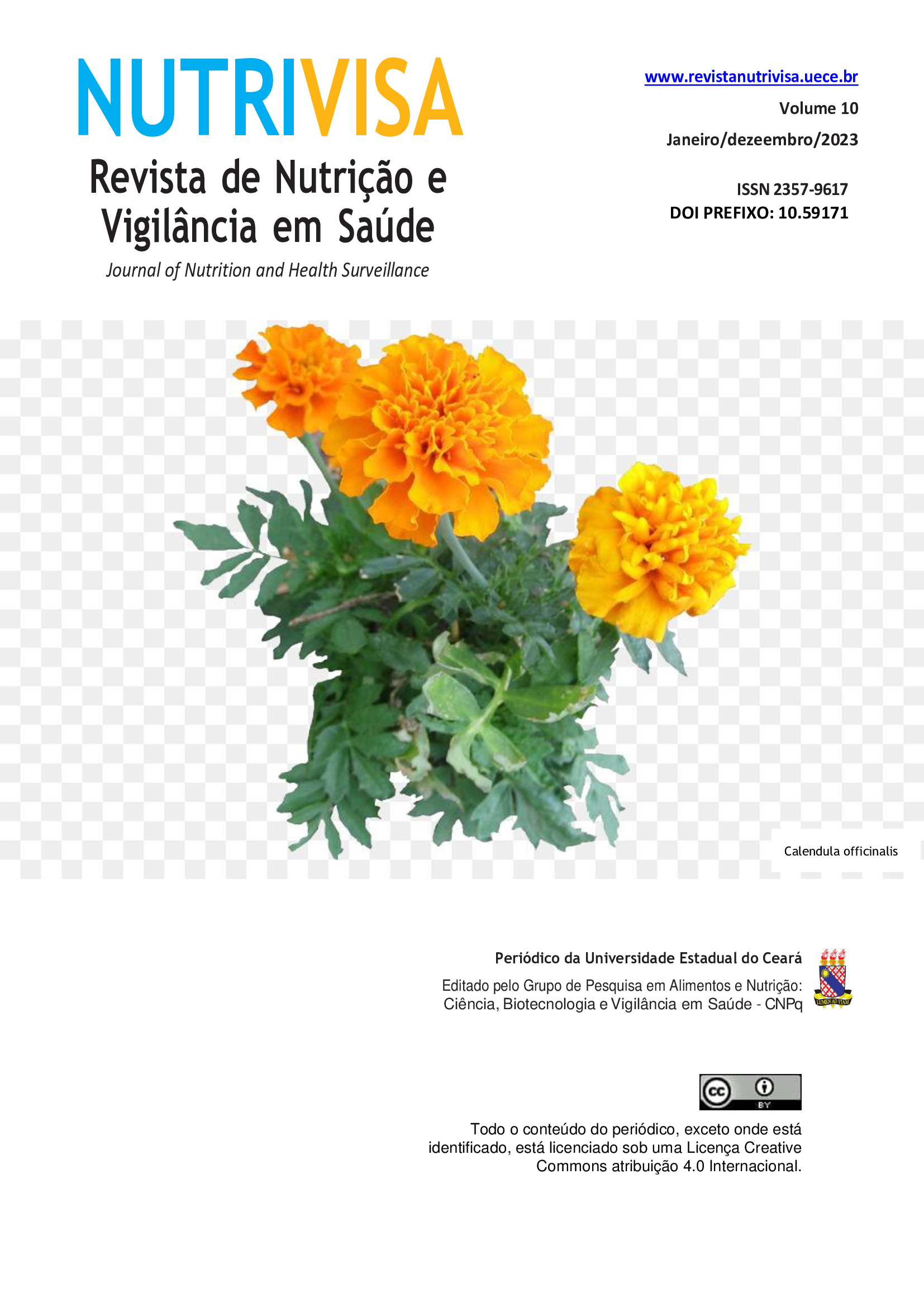Gastronomic variations of mungunzá while traveling Brazil: bibliographic study
DOI:
https://doi.org/10.59171/nutrivisa-2023v10e10513Keywords:
mungunzá, canjica, gastronomy, food cultureAbstract
With corn it is possible to create several preparations, being able to serve it in different ways and satisfy all tastes. Among the preparations, there is mungunzá, food that is consumed in the June festivities, varying its terminologies linked to regionalism. This study aimed to describe the transformations that occurred in the production of mungunzá in Brazil over time. An investigation question was formulated: what transformations occurred in the production of mungunzá in Brazil? A total of 958 works were found based on the search for descriptors in the databases: CAPES, Science Direct, ScieELO and Institutional Repository of the Federal University of Ceará. Only 14 were selected based on content evaluation and literature search. Upon reading the works, it can be seen that hominy, curau, mungunzá, serve to designate different preparations based on corn and are present from north to south of Brazil, diversifying in food and in the linguistic field with similar functions. The nomenclature “munguzá” has an African influence and its consumption is linked to the June and July festivities. The different food trajectories, based on common raw materials, show that gastronomic studies need to take into account cultures and the history of dish production processes. The mungunzá in its salty version is served in the northeastern hinterland as a meal, salty preparations represent energy food, which causes satiety. It is therefore considered that several transformations occur in the production and denomination of mungunzá in Brazil, in the linguistic, historical, cultural, social, geographic and gastronomic fields.
References
BIGNOTTO, L. S.; SCAPIM, C. A.; PINTO, R. J. B.; CAMACHO, L. R. S.; KUKI, M. C., AMARAL JÚNIOR, A. T. Evaluation of combining ability in white corn for special use as corn grits. Crop Breeding and Applied Biotechnology, Viçosa, v. 5, n. 4, p. 258-264, 2015.
CRUZ, M. S. R., & SIMÕES, M. DE L. N. Patrimonio cultural gastronómico y políticas públicas. Inmigración, hibridación e interculturalidad (Región Sur de Bahia-Brasil). Estudios y perspectivas en turismo, Buenos Aires, v. 19, n. 6, p. 1136-1149, 2010.
DAVEL, E. & ROSA, R. S. Gestão, Cultura e Consumo Simbólico no Cortejo Afro. Revista Pensamento Contemporâneo em Administração, Rio de janeiro, v. 11, n. 3, p. 13-30, 2017.
Dicionário Online de Português. (2022). Porto: 7 Graus 2022. Edition. https://www.dicio.com.br/trabalho/.
DONATO, H. & DONATO, M. (2019). Etapas na Condução de uma Revisão Sistemática. Acta Médica Portuguesa, Lisboa, v. 32, n. 3, p. 227-235, 2019.
DÓRIA, C. A. Entre porotos e feijões. Revista de Administração de Empresas, São Paulo, v. 58, n. 3, p. 325-331, 2018.
GORIS, M. B.; SILVA LOPES, I.; VERSCHOOR, G.; BEHAGEL, J.; BOTELHO, M. I. V. (2021). Popular education, youth and peasant agroecology in Brazil. Journal of Rural Studies, v. 87, p. 12-22, 2021.
MAIA, R. P., GUBERT, M. B., KUBO, S. E. A. C. Diferenças no consumo alimentar de adolescentes na Região Centro-Oeste e outras regiões brasileiras. Demetria: alimentação, nutrição & saúde, Rio de Janeiro, v. 9, n. 1, 147-162, 2014.
MONJOLO. In: DICIO, Dicionário Online de Português. Porto: 7Graus, 2022. Disponível em: https://www.dicio.com.br/trabalho/. Acesso em: 18 fev 2022.
NASCIMENTO, S. P., CARVALHO, C. M. Expressões orais populares utilizadas pelo povo do Lavrado em Roraima. Revista Geográfica Acadêmica, Boa Vista, v. 10, n. 1, p. 131-162, 2016.
GURGEL NETO, A. G., COELHO, S. D., OLIVEIRA, C. G. C. O., LIMA, A. E. F. A gastronomía cearense como fomento ao turismo em Fortaleza: a visão dos gestores de A & B dos hotéis Midscale. Conexões: Ciência e Tecnologia, Fortaleza, v. 14, 2, p. 112-117, 2020.
PEREIRA, A. A. da S. Fome e fartura em Rachel de Queiroz. Trabalho de Conclusão de Curso, Graduação em Gastronomia, Universidade Federal do Ceará, Brasil, 2019.
PEREIRA, Isabel Pinheirop. Insumos e doces cearenses. 2018. 30f. Trabalho de Conclusão de Curso (Bacharelado em Gastronomia) – Curso de Gastronomia, Universidade Federal do Ceará, Fortaleza, 2018.
QUEIROZ, R. O Não Me Deixes: suas histórias e sua cozinha. 2ªed. São Paulo: ARX, 2004.
ROCHA, A. M. Há um sistema culinário do milho no Cariri?/Is there a culinary corn system in the Cearense Cariri?. Geografares, Goiabeiras, v. 25, p. 218-237, 2018.
ROVARIS, S. R. S.; OLIVEIRA, A. L. B.; SAWAZAKI, E.; GALLO, P. B.; PATERNIANI, M. E. A. G. Z. Estimativas de parâmetros genéticos e identificação de populações superiores de milho branco. Acta Scientiarum. Agronomy, Maringá, v. 39, n. 2, p. 157-164, 2017.
SANTOS, F. G., BASTOS, S. O papel do festival gastronômico de Taquaruçu na definição da gastronomia de Tocantins/TO. Turismo: Visão e Ação, Balneário Camburiú, v. 18, 3, p. 611-632, 2016.
SANTOS, M. C. L., MENDONÇA, C. M., SHINOHARA, N. K. S. Milho e São João: Identidade Gastronômica. Contexto da Alimentação: Revista de Comportamento, Cultura e Sociedade, São Paulo, v. 8, n. 1, p. 33-44, 2020.
VASCONCELOS, F. A. G. Culinária regional, nacional ou global: Uma revisão narrativa do Manifesto Regionalista de 1926 escrito por Gilberto Freyre. DEMETRA: Alimentação, Nutrição & Saúde, Rio de janeiro, v. 11, 1, p. 3-26, 2016.
VILLELA, F. F. Cultura ambiental no território caipira: história e saberes tradicionais das mulheres do noroeste paulista. Retratos de Assentamentos, Araraquara, v. 19, n. 1, p. 323-350, 2016.
VIOTTI, A. C. C. Da obrigação de alimentar os escravos no Brasil colonial 1. Estudos Históricos, Rio de Janeiro, v. 32, p. 5-32, 2019.
Downloads
Published
How to Cite
Issue
Section
License
Copyright (c) 2023 Fládia Carneiro da Costa, Pedro Abreu da Silva Neto, Diana Valesca Carvalho, Sandro Thomaz Gouveia, Francisca Elisângela Teixeira Lima, Paulo Henrique Machado Sousa

This work is licensed under a Creative Commons Attribution 4.0 International License.














